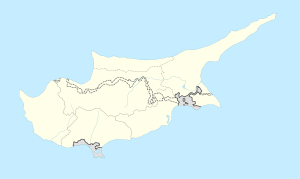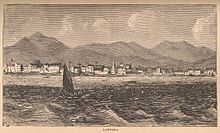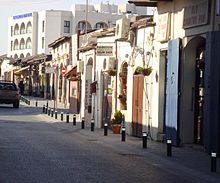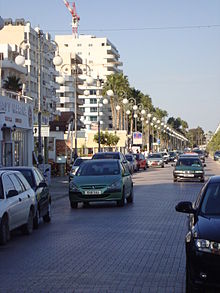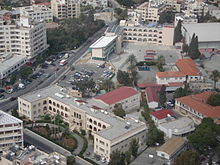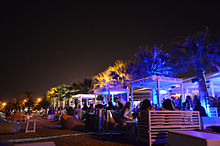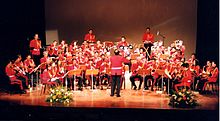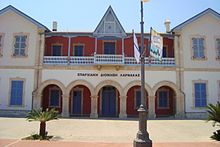- Larnaca
-
Larnaca — Municipality — Λάρνακα (Greek) Larnaka (Turkish) Location in Cyprus Coordinates: 34°55′N 33°38′E / 34.917°N 33.633°ECoordinates: 34°55′N 33°38′E / 34.917°N 33.633°E Country  Cyprus
CyprusDistrict Larnaca District Government - Mayor Andreas Moyseos - Vice Mayor Αlexis Michaelides Population (2010) - Municipality 72,000 - Urban 140,000 Time zone EET (UTC+2) - Summer (DST) EEST (UTC+3) Website www.larnaka.com Larnaca, (Greek: Λάρνακα, Lárnaka or colloquially Skala; Turkish: Larnaka/İskele) is the third largest city on the southern coast of Cyprus after Nicosia and Limassol. It has a population of 72,000 (2010) and is the island's second largest commercial port and an important tourist resort. The island's largest airport, Larnaca International Airport is located on the outskirts of the city.
To the north of the city lies the island's former oil refinery, which was reduced to a storage facility after the refinery itself was sold in 2008. To the south is the Larnaca International Airport. The city of Larnaka is well known for its picturesque seafront which includes rows of palm trees (or φοινικούδες finikoudes, in the Cypriot dialect). Larnaca Marina is one of the four official entry points, by sea, to Cyprus.
Contents
History
Main article: History of LarnacaLarnaca was founded by Greeks (Mycenaean-Achaeans) in the 14th century B.C. and was known as Kition, or (in Latin) Citium. The biblical name Kittim, though derived from Citium, was in fact used quite generally for Cyprus as a whole, and occasionally by the Jews for the Greeks and Romans. Larnaca is colloquially known as "Skala" (Greek: Σκάλα) meaning "ladder" or "landing stage", referring to the town's status in history as an important port.[1]
Like most Cypriote cities, Kition belonged to the Persian or Achaemenid Empire. In 450 BC, the Athenian general Cimon, died at sea defending the city of Citium in a major battle with the Persians. On his deathbed, he urged his officers to conceal his death from both their allies and the Persians. The quote "Και Νεκρός Ενίκα" ("Even in death he was victorious") refers to Kimon. A statue of "Kimon the Athenian" stands proudly on the sea front promenade of modern Larnaca.
Like other cities of Cyprus, it has suffered repeatedly from earthquakes, and in medieval times when its harbour silted up (a sign that the island was deforested and overgrazed) the population moved to Larnaca, on the open seafront farther south. The harbour and citadel have now disappeared. Traces remain of the circuit wall, and of a sanctuary with copious terra-cotta offerings; the large cemetery has yielded constant loot from illicit excavations for more than a century.
Dig practically anywhere in the area from the tennis club past Chrysopolittissa church and you will find evidence of prior civilizations. Much of the yield near the surface is Roman and Venetian. Visit the museum by the Terra Santa Convent to see not only many exhibits but also the dig in their backyard along with Ali Baba's storage jars.
The fort on Larnaca seafront has recently been opened up for better viewing by the removal of the Megalos Pefkos (the Big Tree) and a few other restaurants set up on the sea front by refugees after the 1974 invasion.
Climate
Climate data for Larnaca Month Jan Feb Mar Apr May Jun Jul Aug Sep Oct Nov Dec Year Average high °C (°F) 16.8
(62.2)16.8
(62.2)19.1
(66.4)22.5
(72.5)26.5
(79.7)30.3
(86.5)32.4
(90.3)32.7
(90.9)30.9
(87.6)28.1
(82.6)22.6
(72.7)18.3
(64.9)24.7 Daily mean °C (°F) 12.1
(53.8)11.8
(53.2)13.9
(57.0)17.1
(62.8)21.2
(70.2)25.0
(77.0)27.3
(81.1)27.6
(81.7)25.4
(77.7)22.6
(72.7)17.5
(63.5)13.7
(56.7)19.6 Average low °C (°F) 7.5
(45.5)6.9
(44.4)8.7
(47.7)11.7
(53.1)16.0
(60.8)19.8
(67.6)22.2
(72.0)22.6
(72.7)19.9
(67.8)17.1
(62.8)12.5
(54.5)9.2
(48.6)14.5 Precipitation mm (inches) 77.6
(3.055)40.9
(1.61)34.4
(1.354)17.7
(0.697)8.80
(0.3465)2.70
(0.1063)0.60
(0.0236)0.40
(0.0157)7.10
(0.2795)13.8
(0.543)53.1
(2.091)94.5
(3.72)351.5
(13.839)Avg. precipitation days (≥ 1 mm) 7.9 5.7 4.5 3.1 0.7 0.3 0.1 0.1 0.5 2.1 4.7 8.0 37.6 Sunshine hours 195.3 208.8 238.7 267.0 331.7 378.0 387.5 365.8 312.0 275.9 216.0 179.8 3,356.5 Source: Meteorological Service (Cyprus)[2] Landmarks
The most important site of Larnaca are the ruins of Ancient Kitium. The earliest architectural remains date back to the 13th century BC. The area was rebuilt by Achaean Greeks. The remains of the Cyclopean Walls, made of giant blocks and the complex of the five temples, are particularly interesting.
Another place of interest is the Marble Bust of Zeno, which stands at the crossroads near the American Academy. Zeno was born in Kition (ancient Larnaka) in 334 BC. After studying philosophy in Athens he founded the famous Stoic school of philosophy. Near Larnaca International Airport there is the Larnaca Salt Lake.[3] It fills with water during the winter and is visited by flocks of flamingoes who stay here from November till the end of March. It dries up in the summer. It used to yield a good quality of salt which was is scraped from its dried up surface.The salt from this lake is now considered unfit for human consumption. About half-way between the monument of Zeno and Salt Lake on the right, there is the underground chapel of Ayia Phaneromeni. It is a rock cavern with two chambers. The structure suggests that it once was a pagan tomb, possibly dating back to Phoenician times. The place is credited with various magical properties: thus those who suffer from headaches or other diseases walk three times round it and leave a piece of clothing or a tuft of their hair on the grill in front of the south window. It is also much frequented by girls, whose lovers are overseas, who come here to pray for their safety.
The Church of Lazarus (Agios Lazaros) is another magnificent Orthodox Church in Larnaca which was built in the town over the tomb of St. Lazarus, the brother of Mary and Martha. He died here and was buried in the church named after him. In 890 AD, his tomb was found bearing the inscription "Lazarus, bishop of Larnaca. Four days dead. Friend of Jesus." The marble sarcophagus can be seen inside the church under the Holy of Holies.
The Hala Sultan Tekke is about 5 km (3 mi) west of Larnaka, on the banks of the Salt Lake. It is equivalent to the Christian "monastery". Within the precincts of this Tekke is the tomb of Umm Haram, who was the foster mother of Prophet Mohammed. According to Muslim historical accounts Umm Haram died on this spot in 647 AD while accompanying the Arab invaders. She was buried here and later the Ottomans built the present mosque in her honour.
Another site of interest is the Fort of Larnaca which was erected by the Turks in 1625. This fort is now a museum and its inner courtyard is used as an open air garden - theatre during the summer months, by kind permission of the director of antiquities.
The Old Aqueduct known as "The Kamares", stands outside the town on the way to Limassol. It was built by the Ottoman Governor Koca Bekir Pasha in Roman style in 1745 to carry water from a source about 6 miles south of Larnaka into the town. The aqueduct is illuminated at night.
Economy
Larnaca's economy has been growing since 1975, after the loss of the Port of Famagusta, which handled 80 percent of the general cargo, and the closure of the Nicosia International Airport meant that Larnaca's ports (airport and seaport) had an increasing important role in the economy of the island.
A €650m upgrade of the Larnaca airport has been completed.
Many travel and tour operators and other travel related companies including Eurocypria Airlines have their head offices in Larnaca.[4]
The service sector, including tourism, employs three quarters of larnaca's labor force.
Education
There are over a hundred educational institutions in the city. Larnaca hosts the American Academy, a non-profit making school that is supported by an active multi-functional operation to achieve its core purpose of pre-school to University entrance education of the highest standard. Larnaca also hosts Kimon college, which is a private institution of higher education.
In addition to the various Greek-speaking Elementary schools, Larnaca is home to the Larnaca Nareg Armenian school.
Culture
Arts
Larnaca has a theatre and art gallery both run by the Municipality, and is home to the celebrated Pieridis Museum of Antiquities, founded by Demetrios Pieridis. It is also the location of two art schools, the Alexander College, which specialises mainly in design subjects, the Cyprus College of Art, which concentrates of fine art, and also Intercollege. There is a cultural centre in the Old Town area called the Cornaro Institute, which stages contemporary art exhibitions and other cultural events.
Music
Larnaca boasts a Municipal Band of over 60 musicians competent in all families of musical instruments. Larnaca Municipal Band offers a large repertoire of music, ranging from marching-parade music to Latin, and from Greek favourites to rock and roll. Apart from playing for parades on national holidays, the band also makes regular appearances in various concerts and music festivals throughout Cyprus and abroad, representing both Larnaca and Cyprus internationally.
Sports
 Fans of AEK Larnaca.
Fans of AEK Larnaca.
The city is the home to the football teams AEK Larnaca FC, and ALKI Larnaca FC. Both teams play in a stadium of a city called GSZ Stadium or Zenon Stadium. Since the occupation of the northern part of Cyprus by Turkey in 1974, the two teams of Famagusta, Anorthosis and Nea Salamina, have their own stadiums in Larnaca. "Antonis Papadopoulos" is the Anorthosis' stadium and "Ammochostos" (means Famagusta) is the stadium of Nea Salamina.
Larnaca hosted the European Under-19 Football Championship final, in 1998 and the European Under-17 Football Championship final in 1992.
Cuisine
The beaches of Larnaca are lined with nearly identical seafood restaurants catering to tourists. Although there is lots of continental and international cuisine available in Larnaca, visitors do not miss out on indulging in the local food. Many of the staple dishes involve beans, such as fasoulaki (French beans cooked in red wine with lamb) and louvi with lahana (black-eyed beans with chard). The mezes, or appetisers, are particularly delicious and can almost be a meal in itself. Some of the standard appetisers are potato salad, kohlrabi salad and hot, grilled black olives. Your next course may include village sausage and sheftalia, dolmades and keftedes, kolokassi in tomato sauce and several aubergine-based dishes. Baked or grilled lamb usually appears somewhere in the course of dining, as does some kind of fish. The slow pace of eating and the series of food courses makes dining out in Larnaca a true delight.
Festivals
Much of the activity is centered around the city promenade during the major festivals. The most important of these is Kataklysmos or the Festival of the Flood, celebrated in early summer with a series of cultural events. The festival used to last for about a week, but in recent years, with the increased commercialism of peripheral stalls, rides and temporary loukmades restaurants (a sweet delicacy) it has extended to about three weeks, during which the seafront is closed to traffic in the evenings.
Notable people
- Zeno of Citium, stoic philosopher
- Apollonios of Kition, (physician, 1st c BC, nicknamed ‘the Cypriot Hippocrates’)
- St Lazarus (although not born in Larnaca, he was the first Bishop of the town during 45-63AD and he died there - for the second time)
- Ada Nicodemou, actress
- George Charalambous, actor
- Abu Bekr Pasha, Governor of Larnaca and philanthropist
- Dimitris Lipertis, 1866-1937 (national poet)
- Demetrios Pieridis, 1811-1895 (created the Pieridi Museum)
- Anna Vissi, a Greek-Cypriot singer
- Neoclis Kyriazis, medical doctor and historian
- Mehmet Nazim Adil, the leader of the Nakshbandi Sufi order (or Tekke) was born in Larnaca
- Kyriacos A. Athanasiou, a Cypriot-American academic, entrepreneur, and past-president of the Biomedical Engineering Society
- Stass Paraskos, Artist
- Giorgos Theofanous, Composer
- Garo Yepremian, Former Armenian-Cypriot NFL placekicker, played as a member of the 1972 Miami Dolphins, to date the only team in NFL history to finish with a perfect record.
Municipal Council
The mayor of Larnaca is Andreas Moiseos and the deputy mayor is Alexis Michaelides.[5][6]
The members of the council, according to political party are:
Akel Zaouras Ioannis Zaouras crusas Melekkis Andreas Grigoriou Grigoris Antoniou Chrystalla Nikolaou Floros Xenofon Kyriakides Koukouma Marios Christofidou Leontiadou Emily Georgiou Nikolas DISY Louka Eleni Anastasiou Stasis Nikos Kasoulidou Annoula Evangelou Afxentis Manoli Theologos Tsaggari Floros Sofroniou Lakis Plastira Ilias Tsigaridou Eleni DIKO Alexis Michaelides Iasonides Iasonas Vovides Takis Trifonos Trifonas Prokopiou Georgios Pitsillides Michalakis
EDEK Kitipos Panayiotis EVROKO Elia Elias Transport
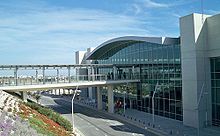 Larnaca International Airport (the largest in Cyprus).
Larnaca International Airport (the largest in Cyprus).
Larnaca International Airport in Larnaca is the main international airport in Cyprus.
Public transport
Public transport in Larnaca is currently served only by buses. Bus routes and timetable can be found here http://www.cyprusbybus.com/routes.aspx?sid=6
International relations
Twin towns — Sister cities
Larnaca Municipality is twinned with the following:
See also
Notes
References
- ^ "www.4larnaca.com". 2011-09-26. http://www.4larnaca.com/. Retrieved 2011-09-25.
- ^ "Meteorological Service - Climatological and Meteorological Reports". http://www.moa.gov.cy/moa/MS/MS.nsf/DMLclimet_reports_en/DMLclimet_reports_en?OpenDocument&Start=1&Count=1000&Expand=1.
- ^ "Larnaca Municipality". Larnaka.com. http://www.larnaka.com/. Retrieved 2009-05-05.
- ^ "Contact Us." Eurocypria Airlines. Retrieved on 6 November 2009.
- ^ "Alexis Michaelides". Michaelidesalexis.blogspot.com. 2009-03-21. http://michaelidesalexis.blogspot.com/. Retrieved 2009-05-05.
- ^ "NETinfo". Michaelidesalexis.com. http://www.michaelidesalexis.com/. Retrieved 2009-05-05.
- ^ "Bratislava City - Twin Towns". © 2003-2008 Bratislava-City.sk. http://www.bratislava-city.sk/bratislava-twin-towns. Retrieved 2008-10-26.
External links
- Municipality of Larnaca Official Web Site
- Larnaka Municipal Wind Orchestra Official Web Site
- Larnaca travel guide from Wikitravel
Municipalities of Cyprus Nicosia District 
Limassol District Ayios Athanasios • Kato Polemidhia • Limassol • Mesa Yitonia • YermasoyiaLarnaca District Famagusta District Paphos District Kyrenia District Larnaca District Settlements Agia Anna • Agioi Vavatsinias • Agios Thedoros • Alaminos • Alethriko • Anafotida • Anglisides • Aplanta • Aradippou • Arsos • Athienou • Avdellero • Choirokoitia • Delikipos • Dromolaxia • Kalavasos • Kalo Chorio • Kato Drys • Kellia • Kiti • Kivisili • Klavdia • Kofinou • Kornos • Lageia • Larnaca • Lefkara • Livadia • Louroujina • Mari • Maroni • Mazotos • Melini • Melouseia • Meneou • Menogeia • Mosfiloti • Odou • Ora • Ormideia • Oroklini • Pergamos • Perivolia • Petrofani • Psematismenos • Psevdas • Pyla • Pyrga • Skarinou • Softades • Tersefanou • Tochni • Tremetousia • Troulloi • Vavatsinia • Vavla • Xylofagou • Xylotymvou • Zygi
Phoenician cities and colonies Algeria: Hippo Regius · Ikosium · Guelma · Iol · Rus Icada · Rus Azuz · Iom · Honaine · Pomoria · Cirta · Rus Ucurru · Rus Aghoun · Rus Ipir · Qart Ina · Siga · Timgad · Lambese · Djémila · Uzinaza · Cuicul · Altava · Igligili · Imonium · Sitifis · Auzia · Rapidum · Portus Magnus · Tipaza · Cyprus: Kition · Italy: Karalis · Lilybaeum · Motya · Nora · Olbia · Panormus · Solki · Soluntum · Tharros · Lebanon: Amia · Ampi · Arqa · Baalbek · Berut · Botrys · Gebal · Sarepta · Sur · Sydon · Tripolis · Libya: Leptis Magna · Oea · Sabratha · Malta: Gozo · Mauritania: Cerne · Morocco: Arambys · Caricus Murus · Lixus · Tingis · Portugal: Olissipona · Ossonoba · Spain: Abdera · Abyla · Akra Leuke · Gadir · Herna · Ibossim · Mahón · Malaca · Onoba · Qart Hadašt · Rusadir · Sexi · Syria: Amrit · Arwad · Safita · Ugarit · Tunisia: Carthage · Hadrumetum · Hippo Diarrhytos · Kerkouane · Leptis Parva · Thanae · Thapsus · Utica · Turkey: Myriandrus · Phoenicus · Gibraltar
Categories:- Ancient Greek cities
- Populated places in Larnaca District
- Phoenician colonies
- Mediterranean port cities and towns in Cyprus
Wikimedia Foundation. 2010.


